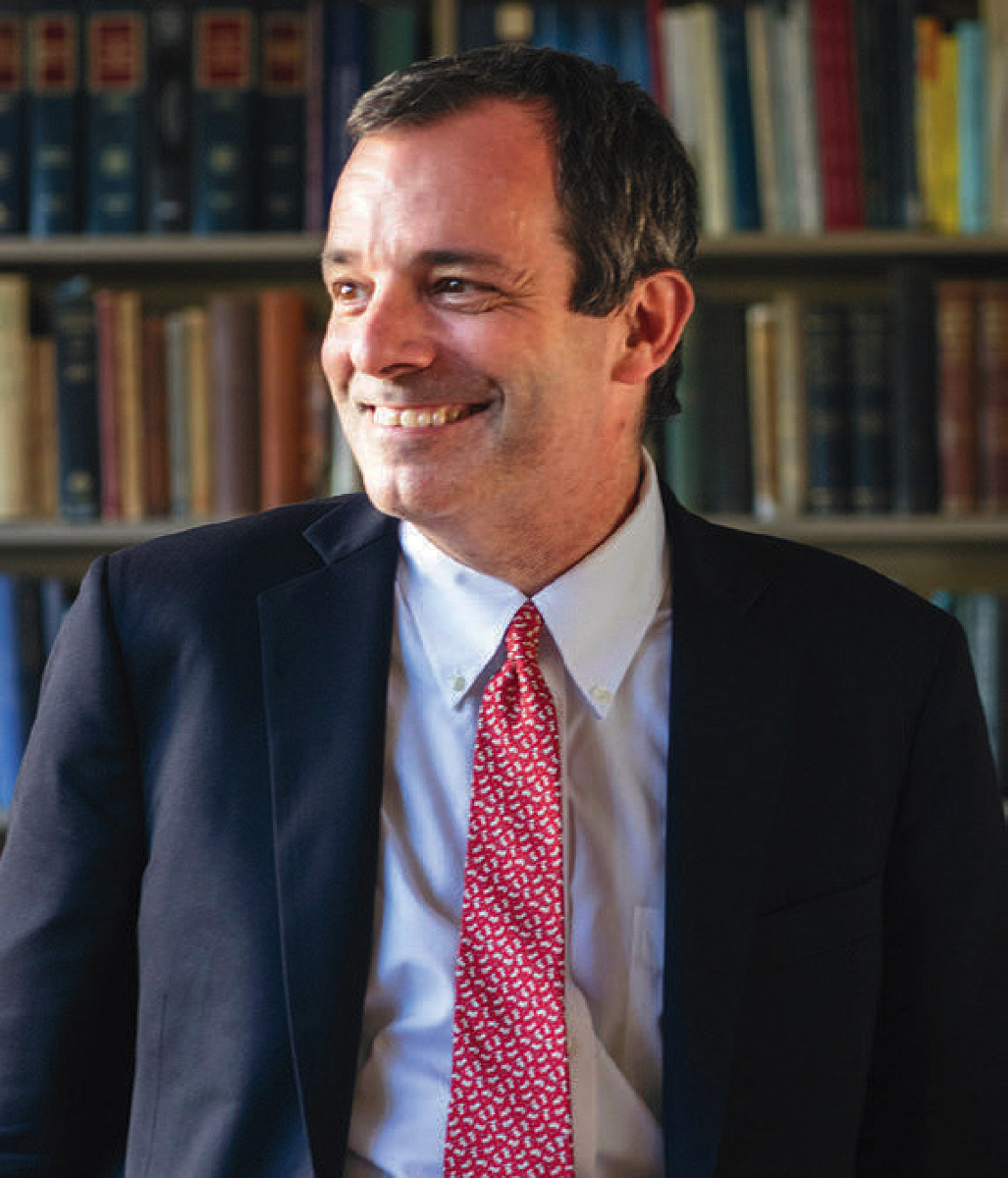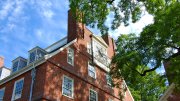Harvard’s new normal began to take shape during the spring semester. New Corporation fellows were appointed (see “News in Brief,” this issue, page 23). Long-time provost Alan M. Garber, who had moved a few yards within Massachusetts Hall on January 2, when he became interim president, succeeding Claudine Gay, made it clear in a mid-February conversation that he would press ahead on pending searches—Kennedy School and Graduate School of Education deans, Harvard Art Museums director, general counsel—and pursue important issues, such as modifying admissions policies in the wake of the 2023 Supreme Court decision outlawing consideration of applicants’ race (see harvardmag.com/garber-agenda-24 and “Admissions Evolving,” this issue, page 19). He also did the other things University presidents do: visiting England during spring break for academic exchanges, an alumni get-together, and donor meetings—followed by more of the latter in Palm Beach.
For their part, undergraduates, up unnaturally early, marched off noisily from their bedrooms on the sodden morning of March 7 to greet first-years in the Yard for the annual Housing Day hoo-ha. Tourists resumed crowding campus. At month’s end, daffodils lit up the south side of Loeb House, where the governing boards meet—perhaps brightening somber discussions inside.
Somber because, beneath the surface, all is not normal. Garber’s to-do list suggests that his interim service will not be brief, as Harvard adapts to the fall crises that culminated in Gay’s abrupt departure. Among priorities, he listed first addressing “longstanding challenges…when it comes to speech,” citing student inhibition and faculty wariness—problems, he said, that are not limited to Harvard. If unresolved, they threaten the academy’s basic premises of enlightened discourse. In the wake of the campus upheavals following Hamas terrorists’ attack on Israel last October 7, Garber created task forces on combating antisemitism and on combating anti-Muslim and anti-Arab bias. Both are charged with documenting community members’ experiences; historical analysis; findings about the nature, extent, and “proximate causes” of bias at Harvard; and recommendations which may encompass student life, University policies, training, and education. The task forces scheduled undergraduate listening sessions beginning the weeks of March 25 and April 1, respectively. A highly unusual Corporation town hall meeting with Faculty of Arts and Sciences (FAS) members was scheduled. And Garber’s sessions with supporters matter, too: fundraising is under pressure.

Underscoring the challenges, and the time the Corporation must take before initiating (much less concluding) a search for a successor president, Garber tapped John F. Manning ’82, J.D. ’85, Harvard Law School’s dean, to serve as interim provost, effective March 14 (see harvardmag.com/manning-provost-24). Alongside his new administrative duties, Manning will lead initiatives on two current concerns: whether Harvard should adopt a policy of institutional neutrality on public issues, and matters surrounding academic freedom and civil discourse.
Atop the University’s usual activities, it would require plenty of its leaders’ time and energy to address any one of these issues. That they now overlap and intersect, urgently, highlights how daunting Harvard’s interim agenda is. Consider some of the difficulties.
• Antisemitism. From the initial student groups’ expression of support for Hamas on October 7 (since modified and, in many cases, repudiated), sympathy for the Gazans killed, wounded, and displaced during Israel’s forceful response has figured prominently on this and many other campuses. That has engendered fierce criticism of pro-Palestinian rhetoric (chants in support of a Palestine “from the river to the sea,” the Intifada, and sanctions of Israel, among other measures), and of actions such as defacing posters of Israelis held hostage by Hamas, as antisemitic.
In February, there was an unambiguous, dismaying example of such bias: a social media post by two pro-Palestinian student groups, subsequently reposted by a faculty and staff group, contained a 1960s image of a hand branded with the Star of David and a dollar sign holding a noose around the necks of two figures (commonly interpreted as Muhammad Ali and Egyptian president Gamal Nasser). Although the image was subsequently disavowed by those who circulated it, condemnation was swift and broad. Harvard announced the post would be examined by the Administrative Board, which reviews undergraduate disciplinary cases. In a February 20 message, Garber reiterated his prior condemnation of the post, and wrote, “Perpetuating vile and hateful antisemitic tropes, or otherwise engaging in inflammatory rhetoric or sharing images that demean people on the basis of their identity, is precisely the opposite of what this moment demands of us.” The post, he wrote, was “grossly irresponsible and profoundly offensive”—and pointedly noted that the Harvard Corporation “join me in unequivocally condemning” the action.
Such incidents form the backdrop for the antisemitism task force’s critical work (even as Garber acknowledged that “Jewish, Israeli, Muslim, Palestinian, and Arab members of our community have reported feeling targeted, rejected, and ostracized”). Nor is the pressure solely internal. The U.S. House Committee on Education and the Workforce (before whom Gay testified on antisemitism on December 5) has followed its information requests from Harvard with a subpoena. (Those requests, and similar ones tailored to other schools, like MIT, are extremely broad, demanding communications from and among administrators and governing boards, disciplinary and fundraising records, and data on diversity and inclusion programs and admissions, among others.) There are other federal investigations. And Students Against Antisemitism has sued the University, with complaints ranging from seemingly serious violations of academic norms to the hyperbolic (characterizing nine students who occupied a room in University Hall as “a mob…[who] took over a campus building”) and the frankly unsupported (alleging that Jewish representation among undergraduates declined from 25 percent in 2013 to 10 percent in 2023, “a drop…that could only evince a deliberate effort by Harvard to minimize its Jewish student population”). At a minimum, much effort will go into responding to the congressional staff and litigants—with little clear effect on improving campus conditions or clarifying speech.
• Speech. Garber’s overriding concern focuses on speech. “As members of an academic community,” he wrote on February 20, “we can and we will disagree, sometimes vehemently, on matters of public concern and controversy,” like the Mideast war. Discourse in the University is severely threatened “when that disagreement devolves into forms of expression that demonize individuals because of their religion, race, nationality, or other aspects of their identity”—as in the circulation of the antisemitic drawing.
But defining the bounds of acceptable, if vehement, disagreement is highly contested, especially now. In a Crimson op-ed, Klein professor of law Randall L. Kennedy, a member of the faculty pro-free speech Council on Academic Freedom at Harvard (CAFH), characterized the student lawsuit as “glaringly tendentious and obviously hyperbolic,” and said that, at its core, it “poses a direct and serious threat to academic freedom.” The litigants, he concludes, argue that Harvard contributes to antisemitism “because it has declined to banish or punish the expression of certain ideas”—logic that “would grievously diminish the intellectual freedom and vitality” that are at the center of the academy, even when addressing odious acts like Hamas’s barbarism.
The nuanced first report, released in March, of Columbia’s Task Force on Antisemitism (organized before Harvard’s), dealt with rules on demonstrations and their enforcement; it indicates how fraught the issues can be. The report grapples with what speech constitutes “discriminatory harassment” and solicits further guidance from the university and the U.S. Department of Education. Whatever the outcome, the task force notes that enforcement “must be consistent in its treatment of different protected classes.” If members of such a group “say that particular phrases or comments interfere with their ability to learn and work, should the University defer to them? Or should the University focus instead—not on how the protected class hears these words—but on what the speakers intend in saying them?” That issue is at the heart of many debates over recent speech at Harvard—and over the intersection of speech and diversity.
• Diversity and inclusion. Critics of diversity, equity, and inclusion (DEI) measures (race-conscious admissions, now outlawed, and the array of campus offices and programs) have latched on to the post-October 7 controversies, arguing that a focus on race, ethnicity, and gender orientation has excluded consideration of Jews as a protected or marginalized group—and therefore fostered insensitive or openly antisemitic speech and behavior. In this view, campus confrontations are still more evidence that DEI initiatives taint discourse and should be abolished. An offsetting perspective might be that such programs need to be extended, to make provision for Jewish community members, given the long human history of antisemitism and persecution.
A late-March panel discussion on DEI, sponsored by FAS, the College’s Intellectual Vitality Initiative, and others, steered clear of these polarized positions, but was largely critical of formal DEI programs. Meanwhile, many faculty and other community members vigorously support those programs.
Again, the University faces difficult decisions. It is deeply committed to diversity and inclusion among students, faculty, and staff, especially for groups that have historically been excluded from the teaching, learning, and research on offer. Current DEI measures may have to be adapted to sustain academic goals, accommodate new laws, and overcome the antisemitism and Islamophobia manifested here, and elsewhere, in recent months.
• Institutional neutrality. A university has a strong interest in asserting an official position on matters of direct academic import: government funding for research, say, or regulations on admissions, faculty appointments, or freedom of speech on campus. But at least two powerful reasons are advanced for remaining silent on other issues, no matter how powerfully they affect members of the community (for example, the current Israel-Gaza war, or the murder of George Floyd by a white police officer in May 2020). From the public’s and politicians’ perspective, institutional position-taking in these realms may subject the university, perceived as a partisan body, to the rough-and-tumble of politics, and perhaps even retribution. And internally, promulgating official positions may constrain or choke off open debate among professors and students who adhere to different perspectives.
Free speech advocates, among them CAFH members, make that argument: the University should be a forum for debates, not a protagonist in them.
The difficulties Manning will have to sort out, in consultation with faculties across the University, include how such a policy applies (read a report on a Radcliffe Institute discussion at harvardmag.com/neutrality-24). As originally articulated at the University of Chicago, institutional neutrality was intended to defend professors’ speech from an overbearing central administration. But does a policy of neutrality mean that, in addition to silencing, say, the president, Harvard would also extend that ban to any kind of official statements by schools, departments, or programs? Which issues fall under the rubric of nonacademic, public matters—and who decides, and how? And is it really good for institutional leaders effectively to neuter their voices on all such matters?
As a thought experiment, consider institutional neutrality in the current circumstances. If it were again the evening of October 7, and student groups issued a statement blaming Israel for what turned out to be brutal Hamas terrorism, how would a Harvard bound to neutrality proceed? Would it denounce the students’ message—effectively establishing limits to acceptable speech on the fly? Would University leaders then feel obligated to take a stance on the larger issues—and what would they say? Would they risk public uproar for doing so? Or would the risk to the institution be reduced (or, as was the case last October, heightened) if they said nothing, hoping a charitable public would discern the difference between student and University expression?
Each of these issues is deeply divisive, and not susceptible to a simple solution. The events since October 7 illuminated the problems, but have, if anything, made nuanced resolutions far harder to achieve. After the traumas of campus division and a presidential departure, Harvard on one level will proceed as usual through the end of the semester and the Commencement celebrations of May 23. But underneath, deep difficulties simmer, and this interim period of addressing them may be protracted and painful.









